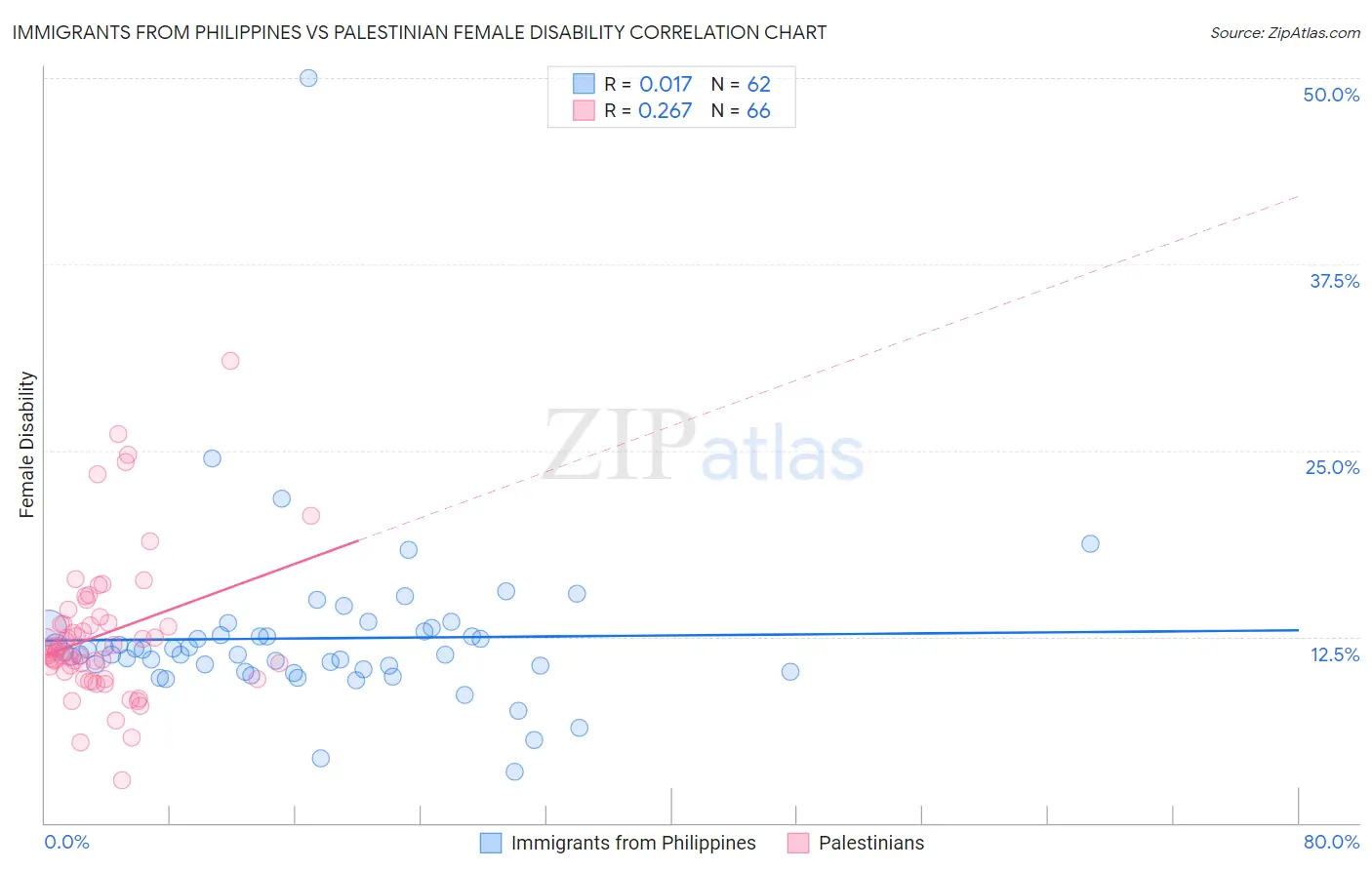Immigrants from Philippines vs Palestinian Female Disability
COMPARE
Immigrants from Philippines
Palestinian
Female Disability
Female Disability Comparison
Immigrants from Philippines
Palestinians
11.7%
FEMALE DISABILITY
98.6/ 100
METRIC RATING
99th/ 347
METRIC RANK
11.6%
FEMALE DISABILITY
99.6/ 100
METRIC RATING
85th/ 347
METRIC RANK
Immigrants from Philippines vs Palestinian Female Disability Correlation Chart
The statistical analysis conducted on geographies consisting of 471,161,268 people shows no correlation between the proportion of Immigrants from Philippines and percentage of females with a disability in the United States with a correlation coefficient (R) of 0.017 and weighted average of 11.7%. Similarly, the statistical analysis conducted on geographies consisting of 216,463,404 people shows a weak positive correlation between the proportion of Palestinians and percentage of females with a disability in the United States with a correlation coefficient (R) of 0.267 and weighted average of 11.6%, a difference of 1.2%.

Female Disability Correlation Summary
| Measurement | Immigrants from Philippines | Palestinian |
| Minimum | 3.4% | 2.8% |
| Maximum | 50.0% | 31.0% |
| Range | 46.6% | 28.2% |
| Mean | 12.4% | 12.7% |
| Median | 11.4% | 11.6% |
| Interquartile 25% (IQ1) | 10.3% | 10.1% |
| Interquartile 75% (IQ3) | 12.8% | 13.4% |
| Interquartile Range (IQR) | 2.6% | 3.3% |
| Standard Deviation (Sample) | 5.9% | 4.9% |
| Standard Deviation (Population) | 5.9% | 4.8% |
Demographics Similar to Immigrants from Philippines and Palestinians by Female Disability
In terms of female disability, the demographic groups most similar to Immigrants from Philippines are Immigrants from Uruguay (11.7%, a difference of 0.050%), Immigrants from Costa Rica (11.7%, a difference of 0.070%), Immigrants from South Eastern Asia (11.7%, a difference of 0.080%), Uruguayan (11.7%, a difference of 0.21%), and Korean (11.7%, a difference of 0.35%). Similarly, the demographic groups most similar to Palestinians are Immigrants from Cameroon (11.6%, a difference of 0.0%), Immigrants from Poland (11.6%, a difference of 0.030%), Immigrants from Serbia (11.6%, a difference of 0.060%), Immigrants from Denmark (11.6%, a difference of 0.070%), and Yup'ik (11.6%, a difference of 0.070%).
| Demographics | Rating | Rank | Female Disability |
| Luxembourgers | 99.6 /100 | #82 | Exceptional 11.6% |
| Immigrants | Serbia | 99.6 /100 | #83 | Exceptional 11.6% |
| Immigrants | Poland | 99.6 /100 | #84 | Exceptional 11.6% |
| Palestinians | 99.6 /100 | #85 | Exceptional 11.6% |
| Immigrants | Cameroon | 99.6 /100 | #86 | Exceptional 11.6% |
| Immigrants | Denmark | 99.5 /100 | #87 | Exceptional 11.6% |
| Yup'ik | 99.5 /100 | #88 | Exceptional 11.6% |
| Vietnamese | 99.5 /100 | #89 | Exceptional 11.6% |
| Immigrants | Romania | 99.5 /100 | #90 | Exceptional 11.6% |
| Immigrants | Zimbabwe | 99.5 /100 | #91 | Exceptional 11.6% |
| Immigrants | Czechoslovakia | 99.5 /100 | #92 | Exceptional 11.6% |
| Immigrants | Sierra Leone | 99.4 /100 | #93 | Exceptional 11.6% |
| Immigrants | Brazil | 99.4 /100 | #94 | Exceptional 11.6% |
| Immigrants | Northern Europe | 99.4 /100 | #95 | Exceptional 11.6% |
| Immigrants | Russia | 99.0 /100 | #96 | Exceptional 11.7% |
| Koreans | 99.0 /100 | #97 | Exceptional 11.7% |
| Uruguayans | 98.8 /100 | #98 | Exceptional 11.7% |
| Immigrants | Philippines | 98.6 /100 | #99 | Exceptional 11.7% |
| Immigrants | Uruguay | 98.5 /100 | #100 | Exceptional 11.7% |
| Immigrants | Costa Rica | 98.4 /100 | #101 | Exceptional 11.7% |
| Immigrants | South Eastern Asia | 98.4 /100 | #102 | Exceptional 11.7% |